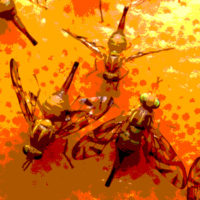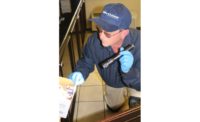Performing a Quality Audit on Your Supplier’s Pest Management Program

The majority of today’s food processing facilities outsource only one component of their food safety system: pest management. Although it is good to have these services provided by dedicated technicians trained in pest management rather than maintenance staff whose job includes other duties, it does not mean your food processing facility is not vulnerable to shortfalls in the pest management service provided.
Just like any other system in a food processing facility, the pest management program must be audited regularly. Use this guide to help determine whether some common pieces of pest management equipment are properly set up and working (see sidebar “Stepping Up Rodent Control”).
 Multiple-catch traps, designed to capture several mice in one setting, form the mainstay of your interior rodent control program (Figure 1). These are typically found around the interior perimeter of your facility. People often think these are designed to capture mice as they run along the walls. People also think mice are attracted to odors escaping through the holes in the trap. Neither of these statements is true. Mice naturally explore new objects in their environment, looking for new food sources and shelter. Before entering a multiple-catch trap, they often investigate it, walking around it, sometimes even jumping on top of it.
Multiple-catch traps, designed to capture several mice in one setting, form the mainstay of your interior rodent control program (Figure 1). These are typically found around the interior perimeter of your facility. People often think these are designed to capture mice as they run along the walls. People also think mice are attracted to odors escaping through the holes in the trap. Neither of these statements is true. Mice naturally explore new objects in their environment, looking for new food sources and shelter. Before entering a multiple-catch trap, they often investigate it, walking around it, sometimes even jumping on top of it.
The trap placement should be along a wall as shown. However, having a trap pulled away from a wall isn’t recommended if you are having a third-party auditor come through. Not all auditors understand how these traps function in relation to mouse behavior, and you might find yourself scoring lower in an audit if the traps are not located in the correct positions.
 Next, you should check the traps for proper function. The best way to check them is to simulate a mouse entering the trap, using your finger or a pen (Figure 2). The floor of the tunnel that the mouse travels through has a plastic pressure plate. If you push down on it, the tunnel should rotate, throwing the mouse into the catch area inside.
Next, you should check the traps for proper function. The best way to check them is to simulate a mouse entering the trap, using your finger or a pen (Figure 2). The floor of the tunnel that the mouse travels through has a plastic pressure plate. If you push down on it, the tunnel should rotate, throwing the mouse into the catch area inside.
If the tunnel doesn’t rotate or rotates slowly, the trap isn’t working properly. The trap could be broken, it might have not been set properly or, if you have a high-vibration environment, it might have unwound on its own.
 Now you need to remove the trap cover and look at its inner workings (Figure 3). The entire interior should be free of any evidence of pests—spider webs, dead insects, mouse feces, fur and carcasses. If it has been a couple of weeks since the pest management provider has serviced the traps, you might find some dead pests in them, so it is best to perform the audit immediately after your regular service.
Now you need to remove the trap cover and look at its inner workings (Figure 3). The entire interior should be free of any evidence of pests—spider webs, dead insects, mouse feces, fur and carcasses. If it has been a couple of weeks since the pest management provider has serviced the traps, you might find some dead pests in them, so it is best to perform the audit immediately after your regular service.
 Rodents living outdoors around the building may try to get inside, looking for food and shelter. Exterior bait stations (Figure 4) are an important tool in preventing this from happening.
Rodents living outdoors around the building may try to get inside, looking for food and shelter. Exterior bait stations (Figure 4) are an important tool in preventing this from happening.
Exterior bait stations must be difficult for a small child or wildlife to move. This can be accomplished by weighting down the station. Some have the station glued or bolted to a block. Other options include staking it to the ground or bolting it to the building.
Exterior bait stations must require a tool to open them. Modern stations have a key, although older stations might be closed with a hex screw or even a zip tie. With older stations, make sure that every station is properly secured.
 When you open the exterior bait station (Figure 5), look for the following:
When you open the exterior bait station (Figure 5), look for the following:
1. First, look at the bait. Notice how it is threaded through a bar. This is important to secure the bait within the station.
2. Next, make sure the bait still appears fresh. What you don’t want to see is bait that has melted from high heat, or moldy or otherwise discolored bait. In addition, if the service has just been performed, none of the bait should show any signs of rodent activity.
3. Finally, the inside of the bait station should be reasonably clean. Plant material, droppings, dead rodents, debris from the bait and the like should be
removed.
By taking these approaches during a quality audit of your supplier’s pest management equipment, you can ensure that your supplier’s pest management program is operating properly and that the equipment is correctly set up and working. As for any other system in a food processing facility, these audits must be conducted regularly. I hope this guide will help you keep your facilities pest-free.
 Ted Snyder, B.C.E., is a Milwaukee, WI-based entomologist who provides consulting services to the pest management and food processing industries. He can be contacted at ted.snyder.ltd@gmail.com.
Ted Snyder, B.C.E., is a Milwaukee, WI-based entomologist who provides consulting services to the pest management and food processing industries. He can be contacted at ted.snyder.ltd@gmail.com.
Stepping Up Rodent Control
Automation has hit the pest control industry in a big way. Rodent stations can be checked via portable scanners. All pertinent information can be entered in databases for historical reviews, and customers can view their data in real time over a secured database. This is convenient for quality control directors with multiple locations. Documentation programs are essential to analyze or review any trouble areas, service histories and records of all materials used on the premises. Many times, this will be the most important information that third-party auditors will examine.
Rats and mice must be controlled in food plants and distribution centers because they damage food containers, contaminating food with droppings and urine and consuming food. The mouse most often found in our industry is the house mouse; the two most common species of rats are the Norway rat and the roof rat. Most rodents are nocturnal and reproduce rapidly, having 20 to 35 offspring per year.
Signs of rodent infestation include droppings, visual sightings, gnawing sounds, oil marks from their fur, tracks that can be seen in dusty areas with flour, gnawing of insulation and wires and urine stains that are detectable under UV light.
To effectively control rodents, you must eliminate their harborages, such as old pallets and retired equipment. Remove all junk and keep the exterior perimeter free of weeds and debris. The next step would be the elimination of food and water sources. Following that, rodent-proof your facility to keep them from coming into the plant or warehouse.
Rodent control should include a combination of tools such as outside baits in secure/tamperproof stations, inside traps such as professional-grade snap traps and large glue boards. Glue boards will catch rats, mice and the occasional invader such as grasshoppers or crickets. Again, all traps and secure/tamperproof bait boxes should be regularly inspected and maintained. Number them and map them out. The bait placement will probably have to be increased during the winter months if activity increases. Inspecting the grounds for Norway rat burrows is very important. Burrows can be treated with rodenticides or toxic tracking powder, but this is a job for the professional.
To preserve your company’s reputation, know your facility’s pest control program and always keep track of the documentation.
Adapted from “Effective Pest Control: The Essentials for Food Processing Plants and Warehouses” by Gary Hugé, Food Safety Magazine, December 2011/January 2012.
Looking for a reprint of this article?
From high-res PDFs to custom plaques, order your copy today!






